People often confuse bilbies with rabbits. These animals used to inhabit large parts of Australia, but unfortunately, they are now constricted to smaller desert areas and have undergone a significant population decline. Let’s find out more about some exciting Bilby facts!
1. Bilby Fun Fact: They Have Many Different Names
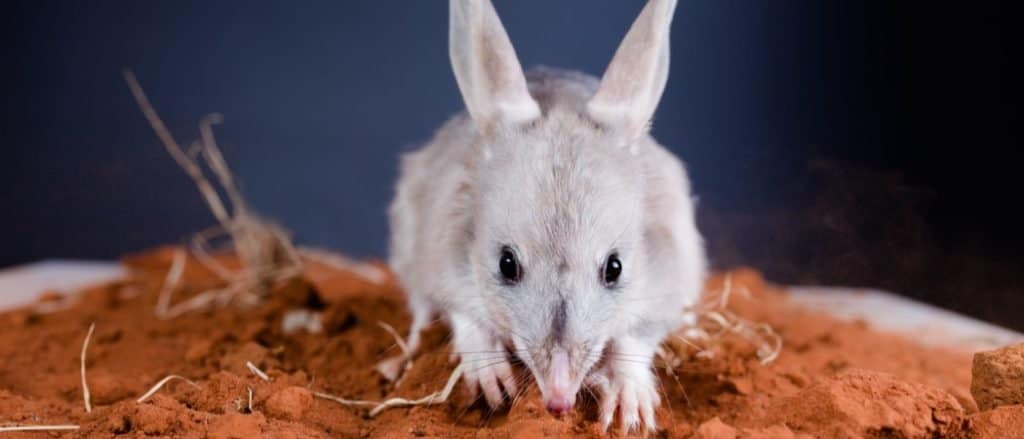
One bilby fun fact is that the bilby, previously known as the greater bilby, takes its name from the Aboriginal word, ‘Yuwaalaraay,’ meaning ‘long-nosed rat.’
©Peter J. Wilson/Shutterstock.com
‘Bilby’ originates from an Aboriginal word, ‘Yuwaalaraay,’ which means ‘long-nosed rat.’ But the proper name of the bilby is the greater bilby. There used to be a different species of bilby known as the lesser bilby, but these animals went extinct in the 1950s. Because of this, the greater bilby became commonly known as the bilby.
2. Bilbies Resemble Rabbits in Many Ways
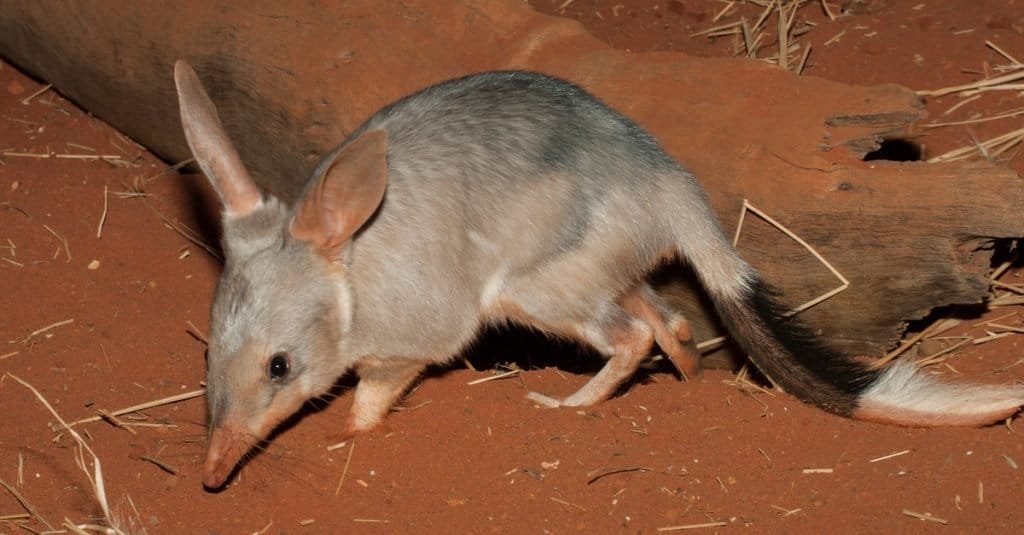
A captive Bilby on red soil. A female bilby’s pouch opens downwards to prevent earth from entering while digging.
©Ken Griffiths/Shutterstock.com
One fun bilby animal fact is that they grow 11 to 22 inches long, with males weighing up to twice as much as females. Male bilbies can grow as big as a rabbit. These animals have silver-gray fur, which feels like silk to the touch. Bilbies have long, pointy ears that keep them cool during summer. They have large canine teeth, a prominent forehead, long snouts, and super sensitive whiskers. Bilbies have a long, thin, sticky tongue to gather termites and ants without destroying their mounds and nests. They also use their tongues to pick up seeds and grains on the ground.
Bilbies have a tri-colored tail that can grow to between 7.9 and 11.4 inches long. The base of the tail is a silver-gray color that transforms to gray before becoming white. Bilbies have strong front legs that they dig with and five toes on each foot. Female bilbies have a pouch that opens in the back, which prevents it from getting filled with dirt when they dig a burrow. Females have eight teats, with some in the pouch. Interestingly, the teats inside the pouch produce milk that helps the embryonic joey to develop, while the teats on the outside provide nourishment after the joey has left the pouch.
3. Bilbies Are Excellent Burrowers
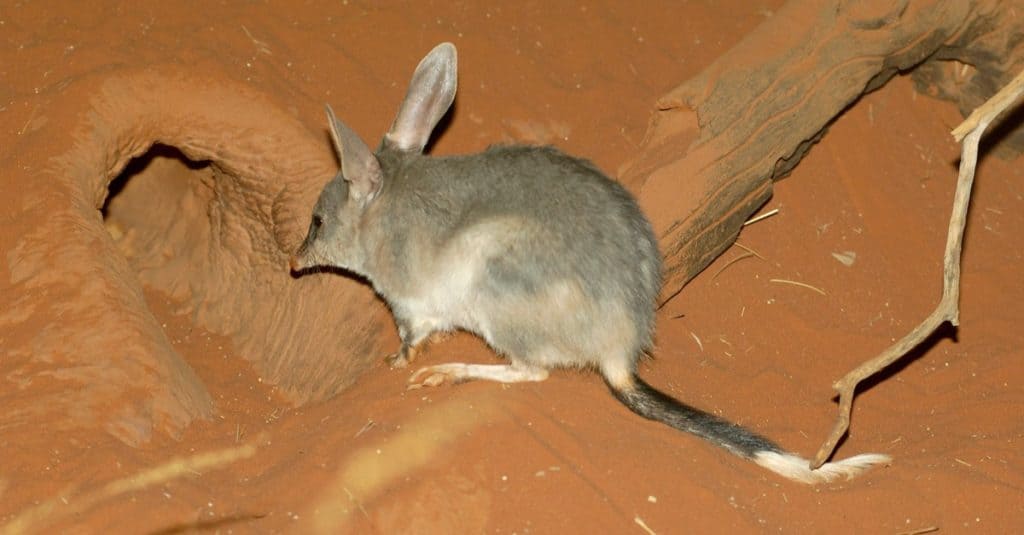
The bilby, dalgyte, or bandicoot digs burrows up to 6.5 feet deep and 10 feet long and is the only desert-dwelling marsupial.
©John Carnemolla/Shutterstock.com
Another fun bilby fact is that bilbies will dig many different burrows with one entrance and several exits. They do so to escape from and deter predators. Bilbies burrow downwards in a spiral shape, with some holes being as expansive as 6.5 feet deep and 10 feet long. These burrows protect them from predators but also from harsh weather. Bilbies usually live alone, but two female bilbies sometimes live together with their young.
4. Bilby Animal Fact: They’re Australian Natives
These animals used to occupy 70 percent of Australia but now mainly live in dry and semi-dry areas with rocky or clay soil, grasslands, and shrublands. Their populations in South Australia have died out. Bilbies love eating grains, bulbs, and shoots, so they prefer to live in areas with regular bushfires. After the fire, the plants in the area germinate, and the fact is that bilbies love to eat fresh new plant growth.
5. Bilbies Are Omnivores
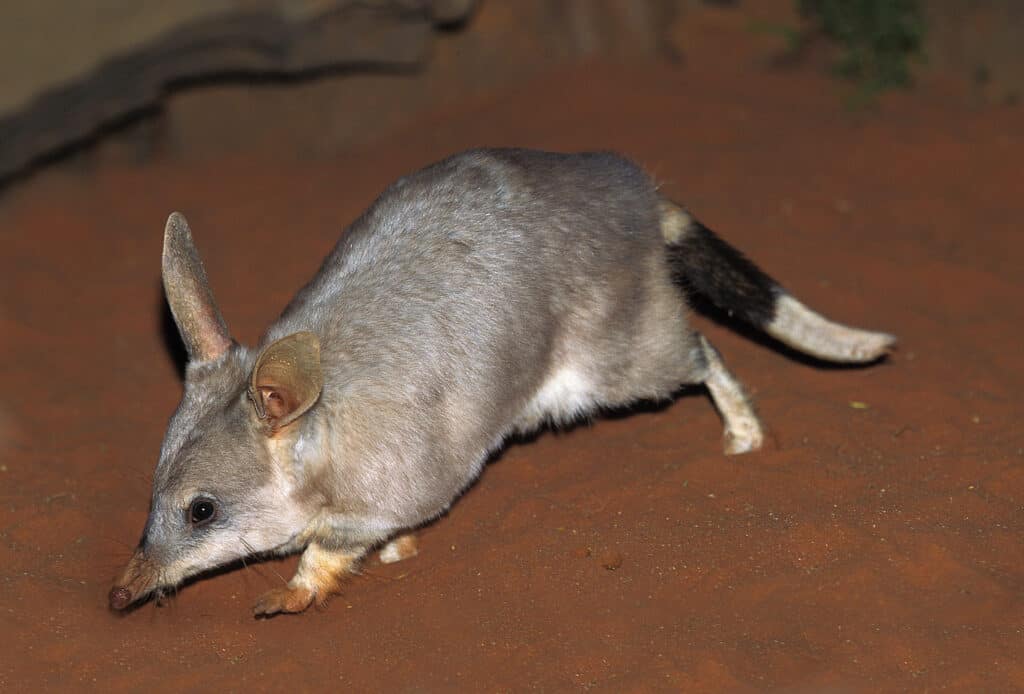
Bilbies have long ears and snouts, so they are often called “rabbit-eared
bandicoots
“.
©iStock.com/slowmotiongli
The bilby’s diet consists of fungi, plants, and animals. The plants that they eat are bulbs, seeds, nuts, grains, grasses, and fruit. The animals they consume include snails, worms, insects, invertebrates, and smaller mammals. Bilbies will also eat bird eggs. Interestingly, these animals do not need to drink water as their food meets their hydration needs. This requirement also determines how many plants or animals they consume.
6. Bilbies Are Considered Vulnerable
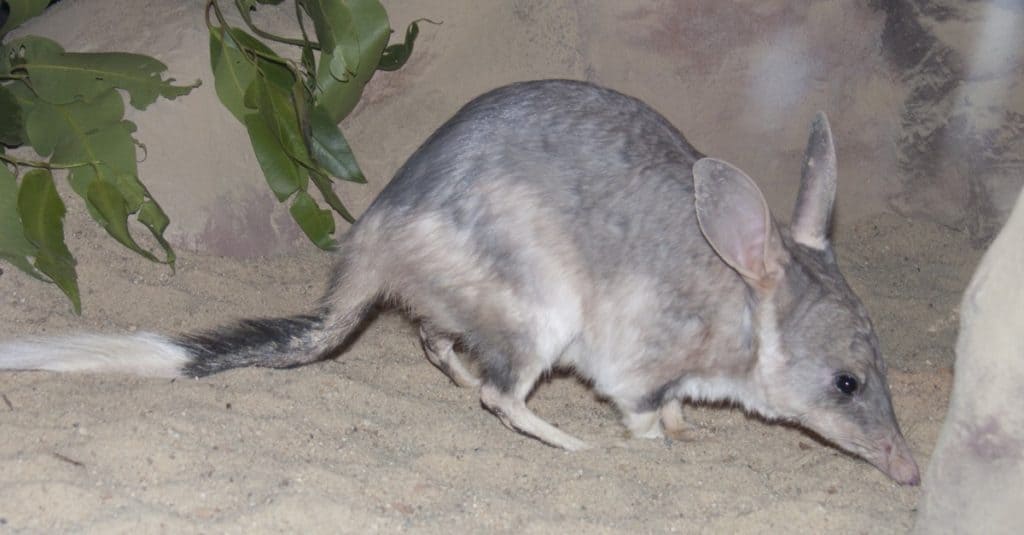
©Susan Flashman/Shutterstock.com
Bilbies are considered vulnerable by the IUCN and endangered under the United States Endangered Species List. Most of the bilby’s natural predators include monitor lizards, birds of prey, carpet pythons, cats, dingoes, and red foxes. The animals that have negatively impacted bilby populations the most are cats, dingoes, and red foxes. All these animals were brought to Australia by humans. The same animals that people introduced to Australia also brought diseases. Unfortunately, many bilbies contracted these diseases as they had no immunity. People also threaten bilbies as they destroy massive parts of their habitat. Often, bilbies also end up as roadkill because of cars killing them on the roads.
7. Unfortunate Bilby Facts: There Are Only 600 To 700 Left
Unfortunately, the sad fact is that there are less than 1,000 bilby’s alive today. These animals used to have a substantial population across Australia, but this declined because of changes to their habitat. Now, there are conservation efforts and initiatives underway to avoid the greater bilby becoming extinct. Their relative, the lesser bilby, is entirely extinct. Their biggest threats are livestock farming and ranching, invasive non-native and alien species, diseases, feral cats, and foxes. Bilbies also have to compete with rabbits for much of their food sources.
8. Australia Doesn’t Have Easter Bunny Chocolates, But Easter Bilby Chocolates

Instead of an “Easter Bunny,” Australia has an “Easter Bilby”! Haigh’s Chocolates in Australia made 950,000 chocolate bilbies between 1993 and 2020 to raise funds to support the conservation of threatened species.
©iStock.com/MillefloreImages
A fun bilby fact is that Haigh’s Chocolates in Australia made 950,000 chocolate bilbies between 1993 and Easter 2020. Donations from these sales are given to the Foundation for Rabbit-Free Australia, which protects indigenous biodiversity from extinction in Australia. National Bilby Day in Australia is on the second Sunday of September. This day serves to increase awareness and secure funding for these conservation projects as well.
9. Bilby Animal Facts: They Communicate Through Scent
Males usually leave scent markings to show dominance and territory. After mating, the male bilby will also leave a scent marking in the female’s burrow. Additionally, dominant males will leave scent marks over the scent marks of subordinate males. Females are not as aggressive and territorial as males and mainly look after the young. Bilbies do not usually bite in times of conflict or threats but will show their canines and deliver a nasal hiss. This hiss is a mixture of a squeak and a grunt.
10. Bilby Facts: They Give Birth to Between One and Four Joeys
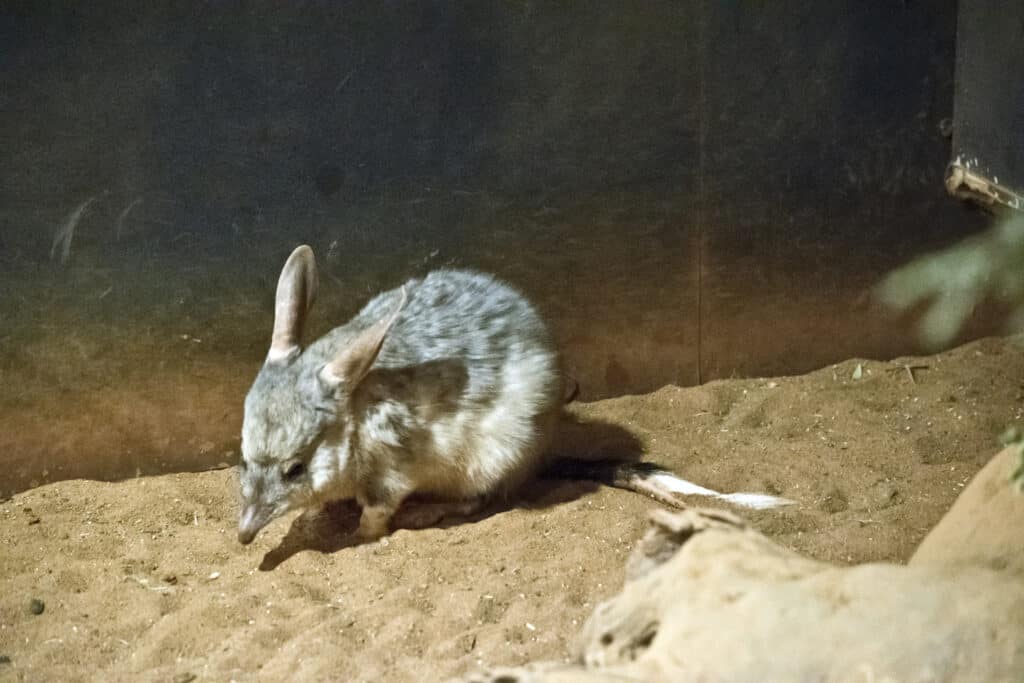
The bilby is a small marsupial similar to a rabbit.
©iStock.com/ozflash
The last fun bilby fact is that the females usually have one to two joeys, but sometimes up to four. These animals breed all year round, with their peak breeding season in the late summer to mid-autumn. Females will avoid breeding if the conditions are too dry or food sources are low. In good conditions, females will have up to four litters per year. Females are pregnant for roughly two weeks before they give birth to the tiny joey, which will live in its mother’s pouch for 75 days. After the joey leaves the pouch, the mother will nurse it for two weeks before it leaves its mother’s burrow. Male bilbies reach sexual maturity at eight months old, and females reach sexual maturity at five months old.
Up Next: Other Indigenous Australian Animals
- Tree Kangaroo
- Quokka Poop: Everything You’ve Ever Wanted to Know
- Potoroo
- Animals in Australia
- Kookaburra
The photo featured at the top of this post is © Susan Flashman/Shutterstock.com
Sources
- A-Z Animals, Available here: https://a-z-animals.com/animals/bilby/
- Kidadl, Available here: https://kidadl.com/facts/animals/greater-bilby-facts
- Tree Hugger, Available here: https://www.treehugger.com/fast-facts-about-the-bilby-4864420
- Britannica, Available here: https://www.britannica.com/animal/bilby
- The Australian Museum, Available here: https://australian.museum/learn/animals/mammals/greater-bilby/
- World Wildlife Fund, Available here: https://www.wwf.org.au/what-we-do/species/bilby
- Queensland Government, Available here: https://www.qld.gov.au/environment/plants-animals/conservation/threatened-wildlife/threatened-species/featured-projects/greater-bilby
Thank you for reading! Have some feedback for us? Contact the AZ Animals editorial team.






